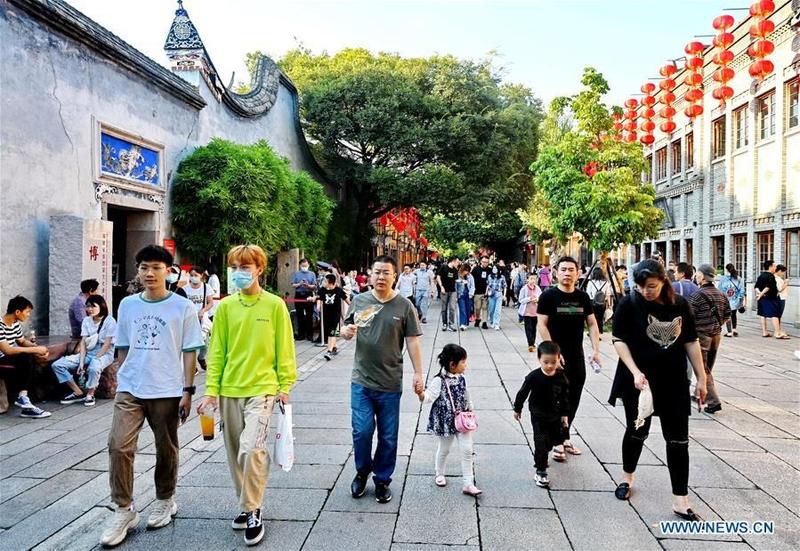 Tourists visit Sanfangqixiang (Three Lanes and Seven Alleys), a scenic spot in Fuzhou, southeast China's Fujian province, Oct 8, 2020. (PHOTO / XINHUA)
Tourists visit Sanfangqixiang (Three Lanes and Seven Alleys), a scenic spot in Fuzhou, southeast China's Fujian province, Oct 8, 2020. (PHOTO / XINHUA)
A nationwide travel boom during the National Day and Mid-Autumn Festival holiday sent a clear signal that China is emerging from the impact of the COVID-19 pandemic.
Figures from the Ministry of Culture and Tourism on Thursday showed that over 637 million visits were made to attractions on the Chinese mainland during the eight-day extended break, compared with 782 million visits during the seven-day holiday in 2019.
Figures from the Ministry of Culture and Tourism showed that over 637 million visits were made to attractions on the Chinese mainland during the eight-day national holiday
On Sept 18, the ministry raised the cap on the number of daily visitors at tourist spots nationwide from 50 percent of operating capacity to 75 percent during the holiday.
Domestic tourism market revenue exceeded 466 billion yuan (US$68.6 billion) during the eight days, compared with 649.7 billion yuan during the holiday last year. The holiday was extended by one day this year to incorporate the Mid-Autumn Festival, which fell on Oct 1, also National Day.
ALSO READ: Half a billion travelers show China moving past COVID-19
Qunar, an online travel service provider, said the Tibet autonomous region and Qinghai and Hainan provinces saw the best recoveries, with reservations to the three destinations on its platform up by more than 30 percent year-on-year.
Among popular attractions, those in northwestern and southwestern provinces that usually take longer to travel to, such as Xi'an in Shaanxi province and Dali and Lijiang in Yunnan province, were preferred by travelers.
Lvmama, another online travel agency, said in a report on Thursday that the 10 most popular destinations on the Chinese mainland over the holiday were: Hangzhou, Zhejiang province; Sanya, Hainan province; Chengdu and the Aba Tibetan and Qiang autonomous prefecture, Sichuan province; Guilin, Guangxi Zhuang autonomous region; Dali and Lijiang; Beijing; Lanzhou, Gansu province; Xiamen, Fujian province; and Xi'an.
READ MORE: China prepares for trip spike
Self-driving tours proved popular with travelers looking for greater privacy amid coronavirus concerns and wanting more relaxed travel schedules.
According to a report by Trip.com, another online travel agency, reservations for cars and self-driving tours hit a record high over the break, with the average number of cars rented on its platform each day up by 50 percent.
Travelers spent an average of about 2,000 yuan on car rental, according to the report.
Northwestern provinces were the big winners in attracting self-driving travelers, with reservations for self-driving holidays up 140 percent year-on-year in Xining, Qinghai province.
Yang Qi, a 35-year-old father of two from Beijing, said he enjoyed his self-driving trip to Zhangye, Gansu.
"Though the coronavirus is well controlled on the mainland, I still wanted a safer traveling environment for my two babies, that's why I chose to drive to Zhangye," he said."We made a loose schedule for the trip and enjoyed every minute we spent together."
Trip.com said the booming self-driving market showed that the tourism sector was shaking off the impact of the pandemic and was on the path to a strong recovery.


